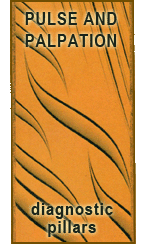The Long Pulse (Chang Mai)

Long Pulse (?? Chang Mai)
Key point: long
Indications: normal (tall person, or young and healthy). Liver yang rising or excess interior heat. Heat causes qi and blood to move excessively leading to expansion of length of pulse.
Explanation: heat causes the blood to move more forcefully. This can result in a fast pulse, a wide pulse, or a long pulse, as the vessel is stressed with a greater pressure internally. This isn’t to say necessarily that a long, fast, or wide pulse indicates hypertension, but the basic mechanism of heat causing these pulses is identical.
The long pulse is defined as the pulse that extends past the proximal (third, cun) position up the length of the arm. This of course is meaningless when you’re feeling the pulse of a tall or otherwise lean and health person. See the “Alism” below on how to compensate for that.
A note about a long pulse going the other direction, extending past the wrist crease on to the thenar eminence. Giovanni Maciocia refers to this as the “special lung pulse”. He says that this pulse suggests an early childhood emotional loss. When I feel this pulse in a patient, I have found about 80% of them to have indeed had a loss of a parent or grandparent who lived in their house. In some cases, there was a divorce in early childhood too. I don’t find this information about an early childhood loss to be of any value therapeutically. However, the patient is usually so impressed by your insight that they become more compliant buydiazepamsite.com with their herbs or consistent with their acupuncture treatments, and THAT has therapeutic value. :)
Alism: the way that I compensate for the length of the arm when assessing the length of the pulse is as follows. It is easy to locate the guan (middle, 2nd) position because it is located above the radial artery at the level of the styloid process of the radius. So there’s a bump there to get you oriented. The cun (distal, 1st) position has a clear boundary as well. It is located proximal yet adjacent to the wrist crease. This means that the finger is placed such that the distal edge is touching but not crossing the wrist crease. Now you’ve got two fingers placed, the cun (distal, 1st) position and the guan (middle, 2nd) as well. If you note how much space there is between these two fingers, you can simply repeat that length in placing the finger over the chi (proximal, 3rd) position.
In most patients, your fingers on the guan and chi positions will be touching. This is indicative of a typical arm length, however in a long arm, you’ll find some space between these two fingers. Let’s say that the space in between these two positions is a half an inch. Just repeat this length between the guan (middle, 2nd) and the chi (proximal, 3rd) position and you’ve successfully compensated for the length of a tall person’s arm such that a “long pulse” is less likely.

The Long Pulse
Next: don’t get short with me!
 Last modified: July 23, 2009
Last modified: July 23, 2009  Tags: Diagnosis, Palpation · Posted in: Pulse Class, Pulse-Palpation
Tags: Diagnosis, Palpation · Posted in: Pulse Class, Pulse-Palpation
